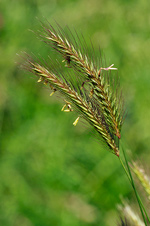|
||||||
|
HORDEUM. Barleys. [Poaceae] |
|
|
Twenty-three species of Hordeum are recorded in Britain. These include the native Sea Barley (H. marinum), Meadow Barley (H. secalinum), Six-rowed Barley (H. vulgare) and Wall Barley (H. murinum). Twenty-five British miners are recorded on Hordeum. A key to the European miners recorded on Hordeum is provided in Bladmineerders van Europa. Nearly 100 British miners or possible miners are recorded on grasses in Britain. It is recommended that adults of all miners on grasses be reared to be certain of their identity. |
|
Key for the identification of the known mines of British |
1# > Leaf-mine: Details unknown. |
|
Liriomyza orbona (Meigen, 1830) [Diptera: Agromyzidae]. |
1# > Leaf-miner: Details unknown. Probably the larva mines for a few days only, and afterwards lives as a stem borer. |
|
Ochsenheimeria urella Fischer von Röslerstamm, 1842 [Lepidoptera: Ypsolophidae]. |
1a > Leaf miner/Stem borer: The larvae mine the stems of various coarse grasses (UKMoths; Plant in Pitkin & Plant, 2005). The larva mines just a few days in the leaf, then continues as a stem borer on the lower part of the stem. They regularly move to a new stem. The central leaves of the infested plants wither and die. |
|
Ochsenheimeria taurella (Denis & Schiffermüller, 1775) [Lepidoptera: Ypsolophidae]. |
1b > Leaf-mine: Blotch, near the leaf tip, containing one or two larvae; pupation outside the mine. |
|
Agromyza luteitarsis (Rondani, 1875) [Diptera: Agromyzidae]. |
1c > Leaf miner: Larvae feed singly, forming an upper surface linear-blotch mine. Pupation either internal or external, with the puparium loosely glued to the leaf (Spencer, 1976: 91). Oviposition near the leaf margin, at some distance from the leaf tip. From there develops an upper-surface corridor-blotch. At first the mine ascends as a narrow corridor towards the leaf tip, then the direction turns and the mine, steadily widening, descends in the direction of the leaf base. Frass irregular, in rather coarse grains. Larva solitary. Pupation mostly outside the mine; in that case the puparium often sticks to the leaf. |
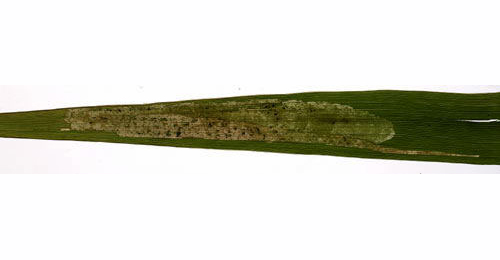 Mine of Agromyza albipennis on Phalaris arundinacea Image: © Willem Ellis (Bladmineerders van Europa) |
|
Agromyza albipennis Meigen, 1830 [Diptera: Agromyzidae]. |
1d > Leaf miner: Leaf-mine normally short and broad (Spencer, 1976: 97). According to Hering (1957) initially the larva does not feed towards the apex of the leaf. Pupation external (Spencer, 1976: 97). The shallow, whtish mine starts (not very close to the base of the lamina) as a fine ascending corridor. This is overrun when the direction alternates, and the mine quickly widens. The final mine is characteristically short; often not the full width of the leaf is used. Frass in big black grains, never greenish. Pupation outside the mine. |
|
Agromyza ambigua Fallén, 1823 [Diptera: Agromyzidae]. |
1e > Leaf miner: A substantial linear mine. Pupation internal; posterior spiracles projecting through the epidermis (Spencer, 1976: 449). Elongated, shallow, upper-surface or lower-surface blotch, not infrequently several in one leaf. Frass in strings or pearl chains. Pupation within the mine. |
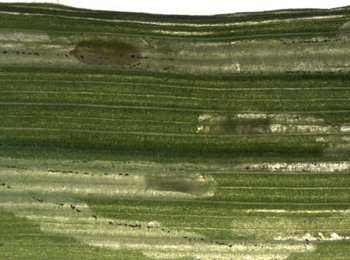 Mine of Chromatomyia milii on Holcus lanatus Image: © Willem Ellis (Bladmineerders van Europa) |
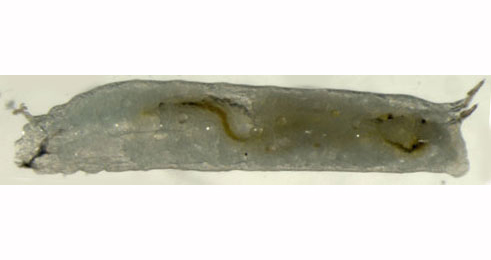 Chromatomyia milii larva, lateral Image: © Willem Ellis (Bladmineerders van Europa) |
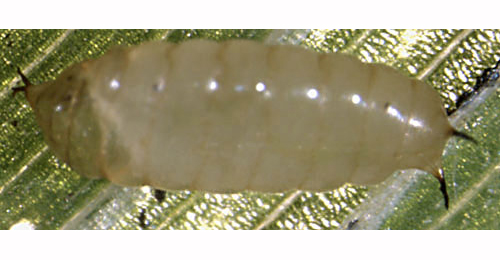 Chromatomyia milii larva, dorsal Image: © Willem Ellis (Bladmineerders van Europa) |
|
Chromatomyia milii (Kaltenbach, 1864) [Diptera: Agromyzidae]. |
1f > Leaf-miner: Long, narrow, whitish mine. Pupation internal (Spencer, 1976: 453); anterior spiracles projecting through the epidermis. Whitish, upper-surface, rather narrow corridor with comparatively large frass grains that are laying further apart than their diameter. Pupation within the mine. The anterior spiracles of the orange-brown puparium penetrate the epidermis. |
 Chromatomyia nigra larva, lateral Image: © Willem Ellis (Bladmineerders van Europa) |
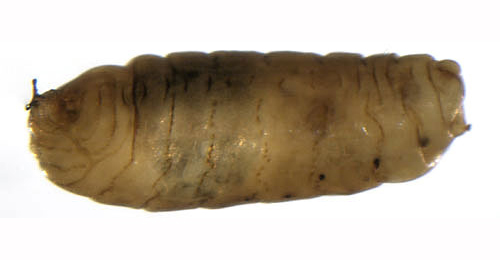 Chromatomyia nigra pupa, lateral Image: © Willem Ellis (Bladmineerders van Europa) |
|
Chromatomyia nigra (Meigen, 1830) [Diptera: Agromyzidae]. |
1g > Leaf-miner: Narrow whitish mine, with frass in distinct black lumps. Pupation internal (Spencer, 1976: 422). Whitish, upper-surface, descending corridor, about halfway up the blade. Frass in distinct black grains that are lying further apart than their diameter. Pupation in the mine. |
|
Chromatomyia fuscula (Zetterstedt, 1838) [Diptera: Agromyzidae]. |
1h > Leaf-miner: Long upper-surface corridor usually containing several larvae that graze shoulder to shoulder from the leaf tip downwards. Pupation outside the mine. Mines and larvae are indistinguishable from those of A. nigrella. |
|
Agromyza mobilis Meigen, 1830 [Diptera: Agromyzidae]. |
1i > Leaf miner: Broad corridor, starting not far from the base of the blade, running upwards. Frass deliquescent, only few grains recognisable, mine greenish. Larva solitary. Pupation outside the mine. Larva: The larvae of flies are leg-less maggots without a head capsule (see examples). They never have thoracic or abdominal legs. They do not have chewing mouthparts, although they do have a characteristic cephalo-pharyngeal skeleton (see examples), usually visible internally through the body wall. The larva is described by Darvas and Papp (1985) and Darvas, Skuhravá and Andersen (2000). Mandibles each with 2 heavy teeth, front spiraculum with 11-14, rear spiraculum with 3 bulbs. The bulbs of the rear spiracula are elongated and S-shaped (d'Aguilar, Chambon and Touber, 1976a; Hering, 1957a, 1962a; Spencer, 1973b). Pupation external. |
|
Agromyza intermittens (Becker, 1907) [Diptera: Agromyzidae]. |
1j> Leaf-miner: Larval leaf-mine starts as a narrow channel running towards apex of leaf but later develops into a broad blotch running downwards. Frass largely diffused, giving the mine a characteristic greenish appearance. Pupation external (Spencer, 1976: 126). Corridor, usually several in one leaf, running from close to the leaf base up to near the tip, then reversing direction and widening, resulting in one communal mine in which the larvae descend in a common front. Frass somewhat deliquescent, mine therefore strikingly green. Pupation outside the mine. Neither mine nor larva distinguishable from those of mobilis. Puparium reddish brown |
|
Agromyza nigrella (Rondani, 1875) [Diptera: Agromyzidae]. |
1k > Leaf-miner: Larvae feeding singly, forming a long, widening mine on the upper surface of the leaf, which is generally limited to one side of the leaf. Pupation external, puparium glued to the leaf near the end of the mine (Spencer, 1976: 128). Broad corridor, generally beginning near the leaf margin or close to the leaf tip. Most of the times the mine remains at one side of the midrib. The mine is upper-surface, but has some full depth, translucent spots here and there. Frass in rather regularly scattered grains. Pupation outside the mine. According to Dempewolf (2004a) only the male genitalia enable a reliable discrimination from A. abipennis and A. graminicola. |
|
Agromyza nigripes Meigen, 1830 [Diptera: Agromyzidae]. |
1l > Leaf-miner: The young larva first feeds towards the apex of the leaf, later turning and feeding downwards. Several larvae can occur together in a single leaf. Pupation external (Spencer, 1976: 130). Upper-surface, greenish, gradually widening corridor, at first running towards the leaf tip, then reverses. Through fusion of several mines the final mine is often communal. Frass in backish green grains, often washed out. Pupation outside the mine. Puparium reddish brown |
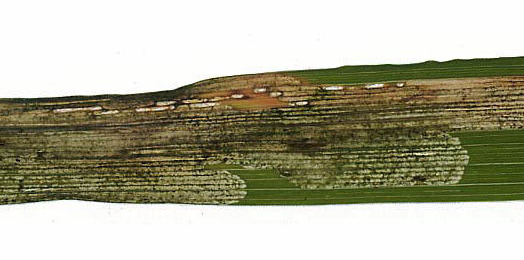 Mine of Agromyza nigrociliata on Arrhenatherum elatius Image: © Willem Ellis (Bladmineerders van Europa) |
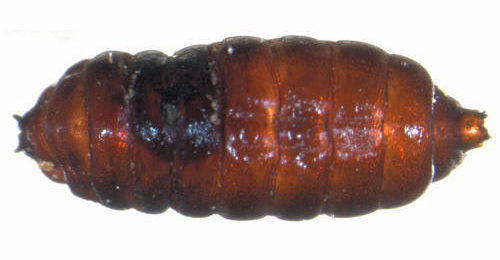 Agromyza nigrociliata puparium Image: © Willem Ellis (Bladmineerders van Europa) |
|
Agromyza nigrociliata Hendel, 1931 [Diptera: Agromyzidae]. |
| 1m > Leaf-miner: Mine greenish with only single larva, initially running towards apex of leaf before turning back down and developing into a broad blotch. Puparium reddish brown. |
|
Agromyza rondensis Strobl, 1900 [Diptera: Agromyzidae]. |
1n > Leaf miner: A short narrow mine, generally near apex of leaf. Larva with each segment bearing a row of characteristic papilli which are retained in the puparium (Spencer, 1976: 328). Pupation internal. Transparent, short and narrow mine not far from the leaf tip. Frass in two rows of grains. Pupation outside the mine. |
|
Pseudonapomyza atra (Meigen, 1830) [Diptera: Agromyzidae]. |
1o > Leaf-miner: Larva feeds mainly in the leaf sheaths. The short mines which may be formed in the leaf blade may be easily overlooked. Pupation internal (Spencer, 1976: 178). Mine begins as a narrow, usually upper-surface, occasionally lower-surface or interparenchymatous corridor in the blade, that descends towards the ligule, thence continues into the leaf sheath, generally on its inside. Usually only one mine per leaf. Puparium in a puparial chamber at the margin of the leaf sheath. Neither mine nor larva can be distinguished from that of C. fulvipes that, as far as is known, only feeds on Poa trivialis. |
|
Cerodontha denticornis (Panzer, 1806) [Diptera: Agromyzidae]. |
1p > Leaf-miner: Broad elongated mine; the form is dependent of the leaf form of the host plant. Frass green. Usually a number of larvae together in a mine. Pupation in the mine. |
|
Cerodontha incisa (Meigen, 1830) [Diptera: Agromyzidae]. |
1q > Leaf-miner: A linear mine running towards the apex of the leaf and this can widen and become almost blotch-like. Pupation internal (Spencer, 1976: 194, 195 (fig. 340). Upper surface corridor, mostly in the lower half of the blade, running upwards, and never occuping more than half the width of the leaf. Larva solitary. Frass in green smears. Pupation inside the mine. |
|
Cerodontha lateralis (Macquart, 1835) [Diptera: Agromyzidae]. |
| 1r > Leaf-miner: Broad lower surface mine which generally starts at the leaf apex.The mine is somewhat irregular in depth. Frass in irregular black-green, frequently melted grains, mostly along the edges of the mine. Larva solitary. Pupation generally internal. |
|
Cerodontha muscina (Meigen, 1830) [Diptera: Agromyzidae]. |
1s > Leaf-miner: Normally several larvae feed together. Pupation in the mine (Spencer, 1976: 198). Broad elongated blotch. Frass greenish. Larvae generally communal. Pupation within the mine. The black puaria are individially anchored within the mine with a silken thread attached at their rear end. Distinguishable from C. incisa only by means of the larva. |
|
Cerodontha pygmaea (Meigen, 1830) [Diptera: Agromyzidae]. |
1t > Leaf-miner: Upper-surface corridor, generally in the upper half of the blade, running up to the leaf tip, usually occupying more then half the width of the leaf. Frass in green stripes at either side of the corridor. Never more than one larva in a mine. Puparium within the mine, metallic black, not anchered with a string of silk. |
|
| Cerodontha superciliosa (Zetterstedt, 1860) [Diptera: Agromyzidae]. |
| 1u > Leaf-miner: A narrow whitish linear mine, running down the leaf from the apex,
with frass in two rows of separate grains. Pupation external (Spencer,
1976: 246).
Narrow corridor from start to end, whitish, uppper- or lower-surface, genarally running downwards. Mine often along the leaf margin. Frass in distict grains of regular size, alternating along the sides of the corridor. Pupation outside the mine. |
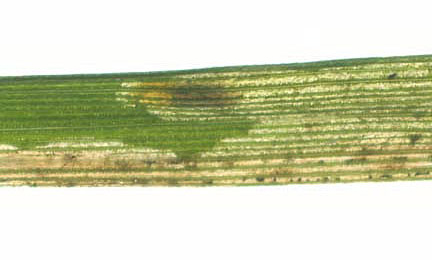 Mine of Liriomyza flaveola on Festuca gigantea Image: © Willis Ellis (Bladmineerders van Europa) |
|
Liriomyza flaveola (Fallén, 1823) [Diptera: Agromyzidae]. |
| 1v > Leaf-miner: Upper surface corridor mine. The mine starts at the leaf apex. Frass in clumps or closely packed grains. |
|
? Liriomyza graminivora Hering, 1949 [Diptera: Agromyzidae]. |
1w > Leaf-miner: Irregular mine, locally shallow, elsewhere much deeper, giving it a mottled appearance. In broadleaved plants the mine often begins as a blotch with stellate extensions, but sometimes as a very fine, shallow corridor. In grasses the mine often begins in the leaf sheath. The frass is very fine-grained, initially scattered, later in aggregates. |
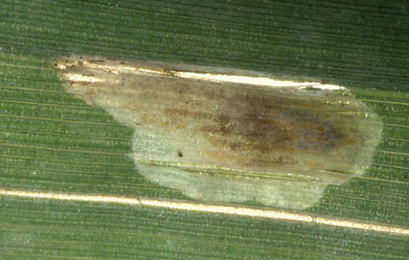 Mine of Hydrellia griseola on Glyceria fluitans Image: © Willem Ellis (Bladmineerders van Europa) |
|
Hydrellia griseola (Fallén, 1813) [Diptera: Ephydridae]. |
| Last updated 05-Jul-2019 Brian Pitkin | ||

